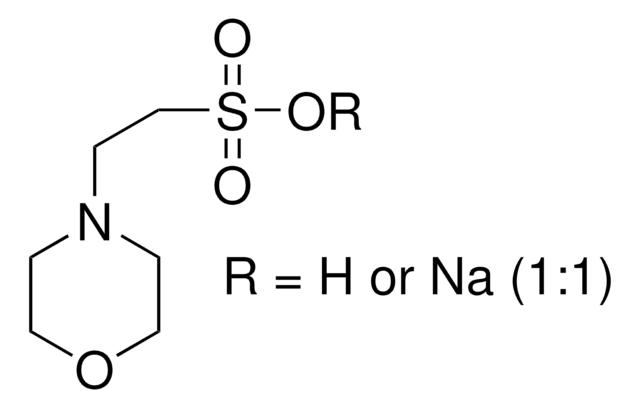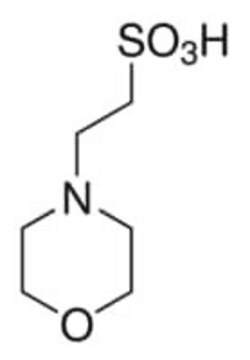M5057
MES
BioReagent, ≥99% (titration), crystalline
Sinônimo(s):
Ácido 2-(N-morfolino) etanossulfônico, Ácido 4-morfolino etanossulfônico
About This Item
Produtos recomendados
linha de produto
BioReagent
Ensaio
≥99% (titration)
Formulário
crystalline
pH
8.9-10.1 (1% in water)
faixa de pH útil
5.5-6.7
pKa
6.1
solubilidade
water: 0.5 g/mL, clear, colorless
aplicação(ões)
diagnostic assay manufacturing
temperatura de armazenamento
room temp
cadeia de caracteres SMILES
[Na+].[O-]S(=O)(=O)CCN1CCOCC1
InChI
1S/C6H13NO4S.Na/c8-12(9,10)6-3-7-1-4-11-5-2-7;/h1-6H2,(H,8,9,10);/q;+1/p-1
chave InChI
IRHWMYKYLWNHTL-UHFFFAOYSA-M
Procurando produtos similares? Visita Guia de comparação de produtos
Categorias relacionadas
Descrição geral
Aplicação
- To achieve the required density and stretching of DNA fibers during melting of agarose plugs containing genomic DNA
- To equilibrate the Balch homogenizer chamber and to prevent sample hydrolysis before sample homogenization
Nota de preparo
Outras notas
Código de classe de armazenamento
13 - Non Combustible Solids
Classe de risco de água (WGK)
WGK 1
Ponto de fulgor (°F)
Not applicable
Ponto de fulgor (°C)
Not applicable
Equipamento de proteção individual
Eyeshields, Gloves, type N95 (US)
Escolha uma das versões mais recentes:
Já possui este produto?
Encontre a documentação dos produtos que você adquiriu recentemente na biblioteca de documentos.
Os clientes também visualizaram
Nossa equipe de cientistas tem experiência em todas as áreas de pesquisa, incluindo Life Sciences, ciência de materiais, síntese química, cromatografia, química analítica e muitas outras.
Entre em contato com a assistência técnica







